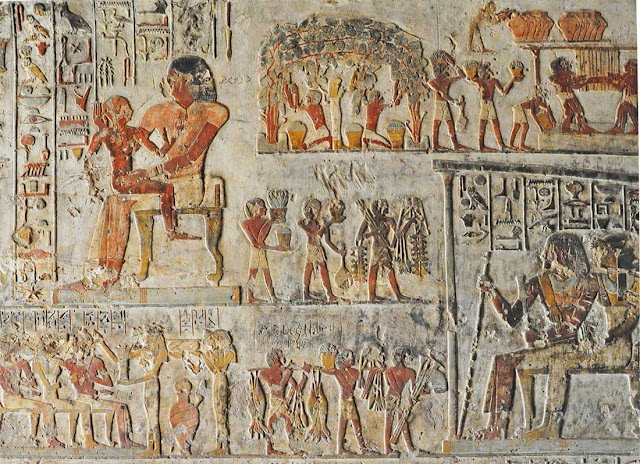Recently I have become interested in depictions of pomegranates, particularly in those of before the Common era and have been collecting these. I find beautiful the fact that the shape and colour of pomegranates (and other fruit) from historical paintings have not changed whilst the people, clothes, lifestyles and other details
depicted alongside
these are long gone. In this post I am going to chronologically list paintings and artworks before the Common era in order to visualise and better understand the "pomegranate culture". I am hoping to update the list whenever I come across a pre-Common era pomegranate depiction.
Ancient Egypt
Pomegranate paintings in Ancient Egyptian tombs are probably the oldest surviving depictions of pomegranates. There are, of course, more tomb paintings of pomegranates than what you will see here.
 | |
| Pomegranates depicted on the red table in the basket next to the grapes and figs in front of Irukaptah who was a butcher of the palace sometime during the Fifth Dynasty (2494 -2345 BC). Image: osirisnet.net |
 |
| Pomegranates in front of Merefnebef who was a vizier from the Sixth Dynasty during the reigns of Userkare and Pepi I (2332 – 2287 BC). Image: osirisnet.net |
 |
| Pomegranates brought to Paheri, who was a governor and a scribe under the reign of Thutmose III (1481-1425 BC); Image: osirisnet.net |
 | ||
| General Djehuty (sitting on the right-hand side) was a general under the reign of Thutmose III (1481-1425 BC); on the left-hand side his grandson (the son of his daughter) Amenemopenakht, is holding pomegranates and fish (offerings); From the tomb of General Djehuty (TT45) carved during the period of Amenhotep II (c. 1427 – 1400 BC). Image: osirisnet.net |
 |
| Pomegranates held by servants on the left-hand and right-hand sides From the tomb (TT52) of Nakht who was a scribe and priest during the reign of Thutmose IV (1401 – 1391 BC ) |
 | |||
| Pomegranates amid other food items. Image: Horus3 (link) from flickr.com From the tomb (TT69) of Menna who was a scribe during the reign of Thutmose IV (1401 – 1391 BC ) |
 |
| A pomegranate amid other food items in front of the sarcophagi . From the tomb of Ameneminet (TT277) who was a priest during the reign of pharaoh Amenhotep III (1391-1388 BC). Image: osirisnet.net |
 |
| A pomegranate on top of other fruit in front of Userhat, his mother Tausert and his wife Hatshepsut. From the tomb of Userhat (TT51). Userhat served in the cult temple of Tuthmosis I during the reigns of Horemheb (1306 - 1292 BC) and Ramesses I (1292-1290). Image and information: osirisnet.net |
 | |
| Mentuherkhepeshef, the son of pharaoh Ramesses IX (1129-1111 BC) presents offerings to Qebehsenuef, the son of Horus in Egyptian mythology. From the tomb of Prince Mentuherkhepeshef (KV19) Image: osirisnet,net |
Hittites
 | ||
| Sumerian relief of the goddess Kubaba , holding a pomegranate in her right hand from Herald's wall, Carchemish (850-750 BC); Late Hittite style under Aramaean influence. Museum of Anatolian Civilizations, Ankara, Turkey. Image: wikipedia |
Lycia (ancient Anatolia)
 |
| The second standing female is holding a pomegranate flower. The seated female on the right is holding a pomegranate. Lycian Harpy Tomb reliefs (480–470 BC). British Museum. Image: Carole Raddato on flickr.com |
Lucania (ancient Southern Italian lands)
There is a number of Lucanian fresco tomb depictions of pomegranates from the IV-III centuries BC. The following five images are examples of Lucanian depictions of pomegranates.
 |
| Image: Carole Raddato / flickr.com |
 |
| Image: Carole Raddato / flickr.com |
 |
| Image: Carole Raddato / flickr.com |
 |
| Image: Carole Raddato / flickr.com |
 |
| Image: Carole Raddato / flickr.com |
Ancient Rome
 |
| Detail of the garden mural from the triclinium in the House of Livia, Rome, circa 30-20 BC. Image: Ian Scott/ flickr.com |

0 comments:
Post a Comment